신생아 여성 유방증(신생아 유방 노장), 가외 젖꼭지(다유방증), The breast enlargement, extra nipple in newborn infants)
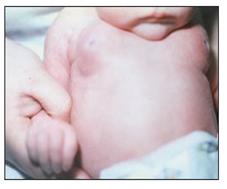
사진 83. 신생아 유방 비대
Copyright ⓒ 2011 John Sangwon Lee, MD., FAAP
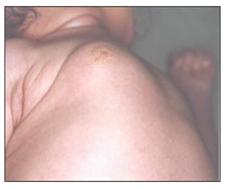
사진 84. 신생아 유방 비대
Copyright ⓒ 2011 John Sangwon Lee, MD., FAAP
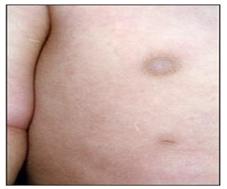
사진 85. 가외 젖꼭지.
비교적 흔한 젖꼭지 기형이다. 정상 젖꼭지가 나 있는 바로 밑에 가외 젖꼭지가 나 있는 것이 보통이다. 대개 무증상징후이다. 더러는 비뇨기계나 심 혈관계의 선천성 기형과 함께 있을 때도 있다. 증상징후가 없으면 관찰적 치료를 한다.
Copyright ⓒ 2011 John Sangwon Lee, MD., FAAP
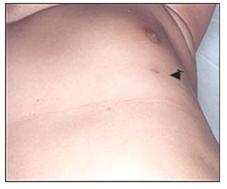
사진 86. 가외 젖꼭지(검은 색 삼각형으로 가르킨 부위)
Copyright ⓒ 2011 John Sangwon Lee, MD., FAAP
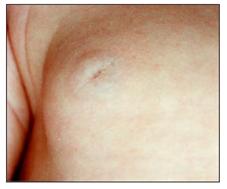
사진 87. 신생아 유방 비대
Copyright ⓒ 2011 John Sangwon Lee, MD., FAAP
- 생후 2∼7일경 남녀 신생아의 한쪽 또는 양쪽 유방이 육안으로 쉽게 볼 수 있을 정도로 커질 수 있다.
- 이런 증상 징후는 출생 전 자궁 내 태아가 태반과 모체로부터 공급받은 에스트로겐 등 여성 호르몬의 영향을 받아 생기는 것이다.
- 초기 사춘기의 남녀 아이들의 유방이 커지는 것처럼 신생아들의 유방도 커지고 젖꼭지의 부위를 중심으로 작은 멍울이 생기면서 유방 전체가 현저히 커질 수 있다.
- 젖멍울이 콩알 크기만 하게 커지든지 밤알 크기만큼 더 커지기도 한다.
- 커진 유방의 피부색은 신체의 다른 부위의 피부색과 거의 같다.
- 커진 유방을 만지면 아프지 않다.
- 손으로 짜면 맑은 젖이 한두 방울 나올 수 있다.
- 그러나 절대로 짜서는 안 된다.
- 가외로 젖꼭지가 하나 더 생길 수 있다([부모도 반의사가 되어야 한다- 소아가정간호 백과]-제 3권- 신생아, 연유아, 학령기아, 사춘기아 성장발육 육아 참조).
| 신생아 유방 비대증(신생아의 유방 노장), 가외 젖꼭지(다유방증)의 치료 |
-
- 신생아 유방 비대증은 생후 2∼3주정도 지나면 커진 유방이 자연히 유방이 정상 크기로 돌아간다([부모도 반의사가 되어야 한다- 소아가정간호 백과]-제 14권 소아청소년 내분비, 염색체, 유전, 대사, 회귀병-순유방 조기 발육증 참조).
- 비대한 유방을 짜면 박테리아 감염이 유방에 쉽게 생길 수 있고 유방염이 생길 수 있다.
- 불결한 손으로 유방을 짜거나 만져서는 절대로 안 된다.
The breast enlargement, extra nipple in newborn infants) 신생아 여성 유방증(신생아 유방 노장), 가외 젖꼭지(다유방증)

Picture 83. Newborn breast enlargement. Copyright ⓒ 2011 John Sangwon Lee, MD., FAAP

Picture 84. Neonatal breast enlargement. Copyright ⓒ 2011 John Sangwon Lee, MD., FAAP

Picture 85. Extra nipple. It is a relatively common nipple deformity. It is common to have an extra nipple just below the normal nipple. It is usually asymptomatic. In some cases, it is accompanied by congenital malformations of the urinary system or cardiovascular system. If there are no symptoms, observe observational treatment. Copyright ⓒ 2011 John Sangwon Lee, MD., FAAP

Picture 86. Extra nipple (indicated by black triangle). Copyright ⓒ 2011 John Sangwon Lee, MD., FAAP

Picture 87. Neonatal breast enlargement. Copyright ⓒ 2011 John Sangwon Lee, MD., FAAP
Around 2-7 days after birth, one or both breasts of male and female newborns can become large enough to be easily seen with the naked eye.
These symptoms are caused by the influence of female hormones such as the placenta and estrogen supplied by the mother in the womb before birth. Just as the breasts of male and female children in early puberty are enlarged, the breasts of newborns are also enlarged and small lumps are formed around the nipple, and the entire breast can be remarkably enlarged. The breast lump grows as big as a bean or as a chestnut.
The skin color of an enlarged breast is almost the same as that of other parts of the body. Touching the enlarged breast does not hurt. A hand or two of clear milk can be produced by hand.
However, it should be never squeezed. In addition, one more nipple may occur ([Parents should also be at least the half-doctors-Encyclopedia of Child and Family Nursing]-Volume 3-Newborns, infants, school-age hunger, puberty, see growth and development).
Treatment of neonatal breast enlargement (newborn breast aging), extra nipples (polymastosis)
In newborn breast enlargement, the enlarged breast naturally returns to its normal size after 2-3 weeks of life ([Parents should also become at least the half-doctors-Encyclopedia of Child and Family Nursing)]-Vol. 14 Pediatric Endocrine, Chromosomes, Genetics, Metabolism, Regression disease-early development of labial breasts).
Squeezing an enlarged breast can lead to bacterial infection in the breast and can lead to mastitis. Never squeeze or touch your breasts with unclean hands.
출처 및 참조 문헌
- NelsonTextbook of Pediatrics 22ND Ed
- The Harriet Lane Handbook 22ND Ed
- Growth and development of the children
- Red Book 32nd Ed 2021-2024
- Neonatal Resuscitation, American Academy Pediatrics
- www.drleepediatrics.com 제1권 소아청소년 응급 의료
- www.drleepediatrics.com 제2권 소아청소년 예방
- www.drleepediatrics.com 제3권 소아청소년 성장 발육 육아
- www.drleepediatrics.com 제4권 모유,모유수유, 이유
- www.drleepediatrics.com 제5권 인공영양, 우유, 이유식, 비타민, 미네랄, 단백질, 탄수화물, 지방
- www.drleepediatrics.com 제6권 신생아 성장 발육 육아 질병
- www.drleepediatrics.com제7권 소아청소년 감염병
- www.drleepediatrics.com제8권 소아청소년 호흡기 질환
- www.drleepediatrics.com제9권 소아청소년 소화기 질환
- www.drleepediatrics.com제10권. 소아청소년 신장 비뇨 생식기 질환
- www.drleepediatrics.com제11권. 소아청소년 심장 혈관계 질환
- www.drleepediatrics.com제12권. 소아청소년 신경 정신 질환, 행동 수면 문제
- www.drleepediatrics.com제13권. 소아청소년 혈액, 림프, 종양 질환
- www.drleepediatrics.com제14권. 소아청소년 내분비, 유전, 염색체, 대사, 희귀병
- www.drleepediatrics.com제15권. 소아청소년 알레르기, 자가 면역질환
- www.drleepediatrics.com제16권. 소아청소년 정형외과 질환
- www.drleepediatrics.com제17권. 소아청소년 피부 질환
- www.drleepediatrics.com제18권. 소아청소년 이비인후(귀 코 인두 후두) 질환
- www.drleepediatrics.com제19권. 소아청소년 안과 (눈)질환
- www.drleepediatrics.com 제20권 소아청소년 이 (치아)질환
- www.drleepediatrics.com 제21권 소아청소년 가정 학교 간호
- www.drleepediatrics.com 제22권 아들 딸 이렇게 사랑해 키우세요
- www.drleepediatrics.com 제23권 사춘기 아이들의 성장 발육 질병
- www.drleepediatrics.com 제24권 소아청소년 성교육
- www.drleepediatrics.com 제25권 임신, 분만, 출산, 신생아 돌보기
- Red book 29th-31st edition 2021
- Nelson Text Book of Pediatrics 19th- 21st Edition
- The Johns Hopkins Hospital, The Harriet Lane Handbook, 22nd edition
- 응급환자관리 정담미디어
- Pediatric Nutritional Handbook American Academy of Pediatrics
- 소아가정간호백과–부모도 반의사가 되어야 한다, 이상원 저
- The pregnancy Bible. By Joan stone, MD. Keith Eddleman, MD
- Neonatology Jeffrey J. Pomerance, C. Joan Richardson
- Preparation for Birth. Beverly Savage and Dianna Smith
- 임신에서 신생아 돌보기까지. 이상원
- Breastfeeding. by Ruth Lawrence and Robert Lawrence
- Sources and references on Growth, Development, Cares, and Diseases of Newborn Infants
- Emergency Medical Service for Children, By Ross Lab. May 1989. p.10
- Emergency care, Harvey Grant and Robert Murray
- Emergency Care Transportation of Sick and Injured American Academy of Orthopaedic Surgeons
- Emergency Pediatrics A Guide to Ambulatory Care, Roger M. Barkin, Peter Rosen
- Quick Reference To Pediatric Emergencies, Delmer J. Pascoe, M.D., Moses Grossman, M.D. with 26 contributors
- Neonatal resuscitation Ameican academy of pediatrics
- Pediatric Nutritional Handbook American Academy of Pediatrics
- Pediatric Resuscitation Pediatric Clinics of North America, Stephen M. Schexnayder, M.D.
-
Pediatric Critical Care, Pediatric Clinics of North America, James P. Orlowski, M.D.
-
Preparation for Birth. Beverly Savage and Dianna Smith
-
Infectious disease of children, Saul Krugman, Samuel L Katz, Ann A.
- 제4권 모유, 모유수유, 이유 참조문헌 및 출처
- 제5권 인공영양, 우유, 이유, 비타민, 단백질, 지방 탄수 화물 참조문헌 및 출처
- 제6권 신생아 성장발육 양호 질병 참조문헌 및 출처
- 소아과학 대한교과서
|
Copyright ⓒ 2015 John Sangwon Lee, MD., FAAP 미국 소아과 전문의, 한국 소아청소년과 전문의 이상원 저 “부모도 반의사가 되어야 한다”-내용은 여러분들의 의사로부터 얻은 정보와 진료를 대신할 수 없습니다. The information contained in this publication should not be used as a substitute for the medical care and advice of your doctor. There may be variations in treatment that your doctor may recommend based on individual facts and circumstances. “Parental education is the best medicine.” |